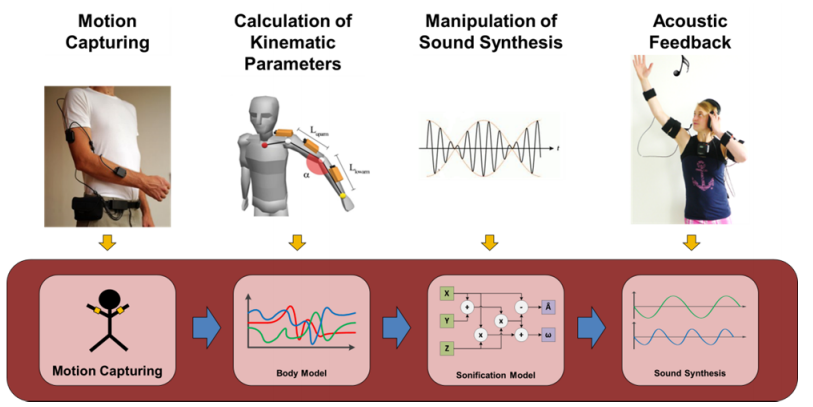Mobile platform for real-time sonification of movements for medical rehabilitation
The rehabilitation of stroke patients is an intense and lengthy process. According to [1] 3% to 4% of all direct costs of the European health care system are caused by stroke patients. Besides ambulatory (40 %) and stationary treatment (22 %), with 21 % rehabilitation accounts for the third highest part of these costs. With a look at the health care system of the United States, a similar trend emerges [2]. The common therapy is based on movement training in presence of a therapist. Through many repetitions a remobilization of the patient is reached. Due to this highly time‐consuming treatment, the costs of for the therapist are very high.
Therefore, in this TTP, we are focusing on the design of a mobile system which will provide a motion feedback by means of sonification. It will enable therapist‐independent training and as a result lessen the strain on patient and healthcare system.

For a reliable sonification of movements a highly accurate motion capturing system has to be used. Camera‐ based systems which are well known as highly reliable require a stationary setup and a permanent line of sight between the tracked objects and multiple cameras. In contrast, mobile and wearable inertial sensors can be easily attached to the human body [8]. This is mandatory for human motion capturing in sport training sessions or medical applications.
MediTECH, as a company with a strong background in biofeedback applications, is an ideal partner to enable transfer from academic prototype to medical product. The purpose of this TTP is to test and improve the every step from motion capturing to acoustic feedback and to derive a system, which is not only capable of performing the aforementioned tasks, but is also designed for manufacturing.

The system is comprised of multiple motion capturing units and a smart phone. The motion capturing units transmit their sensor data to the smartphone via Bluetooth Low Energy. Sensor fusion, combination of the calculated orientation(s) with the body model and sonification downstream are performed on the smart phone resulting in a compact and affordable system.
In the TTP an existing version of this system is analyzed regarding its quality (e.g. orientation estimation quality, endurance) and its product suitability (price per unit, ease of use, update capabilities). This involves sensor characterization in both static and dynamic scenarios and determining concurrently achievable sampling rates, but also battery lifetime and battery charge behavior. As a result of this analysis, which will consume roughly half of the TTP period, a set of measures will be compiled in order to improve both quality and product suitability. As a last step these improvements will be introduced in software, firmware and hardware. While the final HW and SW generation are currently in the making, Leibniz University has successfully transferred HW and SW design expertise for motion capturing units using Bluetooth Low Energy to MediTECH.